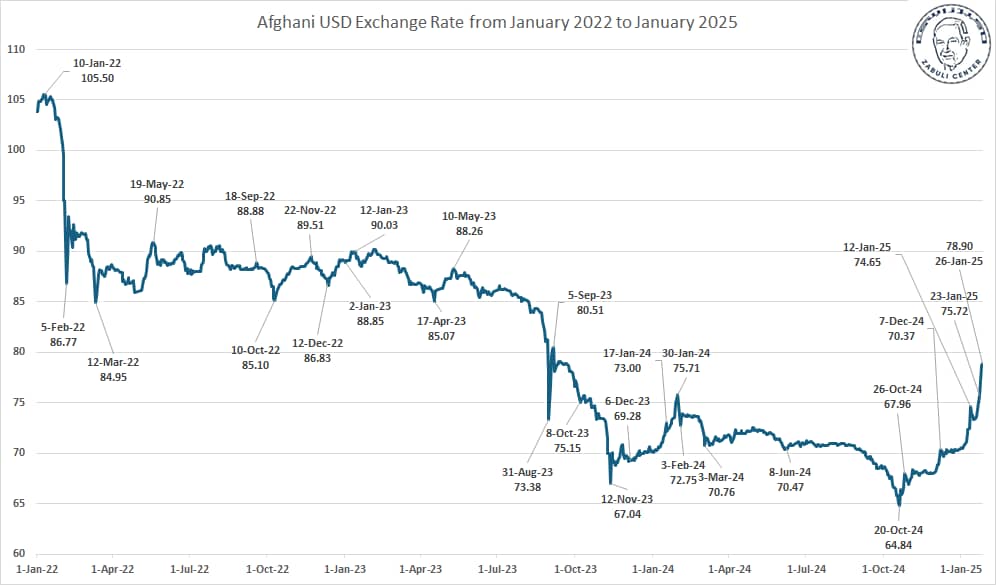26 May,25
Most Searched Keywords
05 Feb
How the Foreign Exchange Market Operates, What’s Happening in the Market, and What the Data Says

How the Foreign Exchange Market Operates, What’s Happening in the Market, and What the Data Says
By Shoaib Rahim for the Majid Zabuli Economic Research Center
In recent weeks, the depreciation of the Afghani against the US dollar has put pressure on the foreign exchange market and the country's economy, causing concerns among the general public. Why is this happening, and apart from political pressures, are there other factors at play? This issue requires in-depth analysis and discussion.
First, we need to understand how exchange rates are determined and how the forex market functions. Exchange rates are primarily set by the forces of supply and demand in the market. If there is high demand for dollars and an insufficient supply, the value of the dollar increases against the Afghani. Conversely, if there is a higher supply of dollars compared to demand, the Afghani strengthens against the dollar.
For example, during Eid celebrations, Afghan expatriates send remittances to their families in Afghanistan to purchase necessary goods. This influx of foreign currency increases the supply of dollars in the market, while locals demand Afghani to purchase goods, strengthening the Afghani. In contrast, economic activity slows down in winter, leading to reduced trade and lower demand for Afghani, which causes its depreciation.
Seasonal Factors Affecting the Afghani
Afghanistan's economy is largely agricultural, and economic activity fluctuates with the seasons. During summer, trade, agriculture, and social events such as weddings increase, boosting demand for the Afghani. However, in winter, economic transactions decline, and with them, the demand for Afghani drops, leading to depreciation.
How the Forex Market Operates
Exchange rates are determined in Afghanistan’s primary forex market, Sarai Shahzada, through an open auction process known as "bidding" (Boli). Currency traders sell foreign currencies, and buyers bid on them, causing exchange rates to fluctuate multiple times a day.
For instance, importers need to buy dollars to pay for goods purchased abroad, while exporters receive payments in dollars but need Afghani for local transactions, leading them to sell dollars in the market. Similarly, international organizations and NGOs that receive foreign funding either supply or purchase Afghani, affecting exchange rates.
Beyond supply and demand, market psychology also plays a role in exchange rate fluctuations. News, reports, or political developments—such as anticipated policy changes—can create uncertainty in the market. Traders may start hoarding or selling currencies based on speculation, impacting exchange rates. This phenomenon is known as "market jittery."
Moreover, currency smuggling to neighboring countries, particularly Iran and Pakistan, also puts pressure on the Afghani. Despite the market’s self-regulation, Afghanistan's central bank (Da Afghanistan Bank) intervenes through monetary policies, such as auctioning US dollars or restricting market transactions, to stabilize the exchange rate.
Why the Recent Depreciation of the Afghani is Concerning
Majid Zabuli Economic Research Center analyzed exchange rate trends over the past three years using daily data from Da Afghanistan Bank. The findings show a seasonal trend:
The Afghani typically appreciates in February, March, and April, when economic activity picks up.
From May to July, exchange rates remain relatively stable.
From August to October, the Afghani tends to strengthen.
From November to January, the Afghani depreciates due to lower demand and reduced economic activity.
For example, in October 2024, the Afghani strengthened to 66 per US dollar, compared to 81 per dollar in October 2023. However, by January 2025, it depreciated to 80 per dollar—a pattern similar to previous years.
However, this year, in addition to seasonal factors, political pressures from the United States have worsened the situation.
The Impact of U.S. Political Statements on the Afghani
On January 9, 2025, U.S. Congressman Tim Burchett proposed a bill to ensure that American aid money does not reach the Taliban and requested reports on cash assistance programs and frozen Afghan assets. Previously, former U.S. President Donald Trump had also called for a tougher stance on Afghanistan.
Although there was no direct announcement of aid cuts, the uncertainty created panic in the forex market, causing further depreciation of the Afghani. Despite Da Afghanistan Bank’s intervention—such as dollar auctions and market restrictions—the Afghani remains under pressure. The exchange rate fell from 71 per dollar on January 1 to 80 per dollar by January 26, 2025.
As expected, inflation followed, increasing the prices of essential goods, which negatively affected Afghan households. If this situation continues unchecked, the country could face a serious economic crisis.
Can This Situation Be Managed?
Before discussing solutions, it's important to assess whether the U.S. is truly focused on Afghanistan.
Trump’s statements included provocative remarks about multiple countries, not just Afghanistan.
Burchett’s proposal does not call for cutting aid but rather ensuring transparency in aid distribution.
Humanitarian aid follows strict mechanisms, making it unlikely that assistance will suddenly stop.
Many ongoing and upcoming aid projects are already funded, ensuring that dollar inflows will continue for the next few months.
Given this, the market panic may be unwarranted. If Da Afghanistan Bank reassures traders about sufficient dollar reserves, the situation could stabilize. Moreover, if the U.S. confirms continued aid, market sentiment will improve.
The Historical Trend of the Afghani
Past data indicates that the Afghani consistently depreciates in January:
January 2022: 105 per dollar
January 2023: 90 per dollar
January 2024: 75 per dollar
However, in each case, the Afghani recovered in the following months.
If aid flows continue and political tensions ease, the Afghani may strengthen once again. However, long-term economic stability requires structural reforms to reduce Afghanistan’s dependence on foreign currency.
Conclusion
While the recent depreciation of the Afghani has caused economic distress, it follows a predictable seasonal pattern. Additionally, political factors have exacerbated the situation, but there is no concrete evidence of imminent aid cuts. If managed properly, Afghanistan can navigate through this period and restore currency stability. However, long-term economic solutions are necessary to prevent recurring crises.
